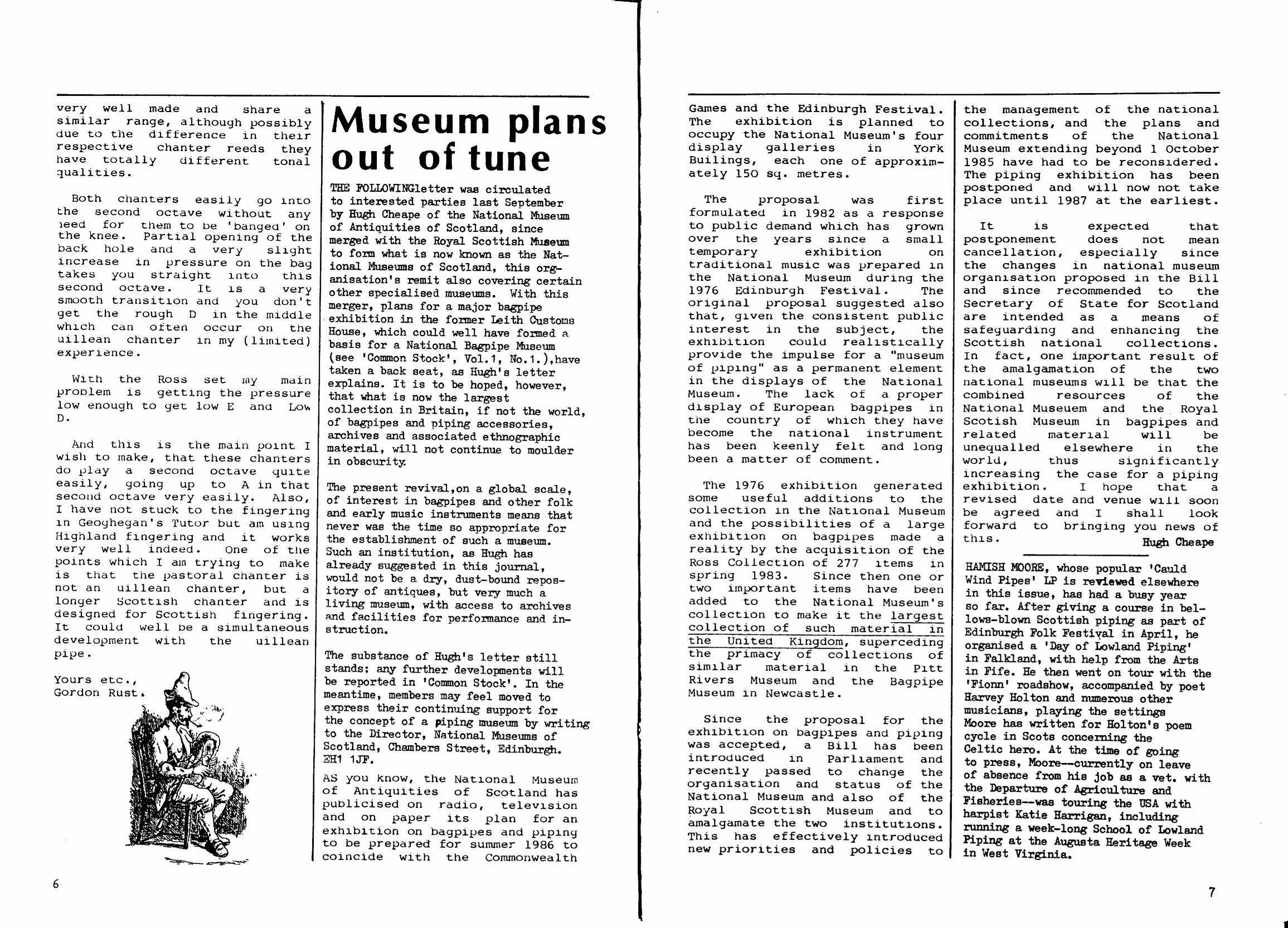Museum Plans Out Of Tune

THE FOLLOWING letter was circulated to interested parties last September by Hugh Cheape of the National Museum of Antiquities of Scotland, since merged with the Royal Scottish Museum to form what is now known as the National Museums of Scotland, this organisation's remit also covering certain other specialised museums. With this merger, plans for a major bagpipe exhibition in the former Leith Customs House, which could well have formed a basis for a National Bagpipe Museum (see ‘Common Stock', Vol.1, No.1. ), have taken a back seat, as Hugh's letter explains. It is to be hoped, however, that what is now the largest collection in Britain, if not the world, of bagpipes and piping accessories, archives and associated ethnographic material, will not continue to moulder in obscurity
The present revival, on a global scale, of interest in bagpipes and other folk and early music instruments means that never was the time so appropriate for the establishment of such a museum. Such an institution, as Hugh has already suggested in thie journal, would not be a dry, dust~bound repository of antiques, but very much a living museum, with access to archives and facilities for performance and instruction.
The substance of Hugh's letter still stands; any further developments will be reported in 'Common Stock’. In the meantime, members may feel moved to express their continuing support for the concept of a piping museum by writing to the Director, National Museums of Scotland, Chambers Street, Edinburgh.
2H1 1JF.
As you know, the National Museum of Antiquities of Scotland has publicised on radio, television and on paper its plan for an exhibition on bagpipes and piping to be prepared for summer 1986 to coincide with the Commonwealth Games and the Edinburgh Festival. The exhibition is planned to occupy the National Museum's four display galleries in York Builings, each one of approximately 150 sq. metres. The proposal was first formulated in 1982 as a response to public demand which has grown ever the years since a_ small temporary exhibition on traditional music was prepared in the National Museum during the 1976 Edinburgh Festival.
The original proposal suggested also that, given the consistent public interest in the subject, the exhibition could realistically provide the impulse for a "museum of piping" as a permanent element in the displays of the National Museum. The lack of a proper display of European bagpipes in the country of which they have become the national instrument has been keenly felt and long been a matter of comment.
The 1976 exhibition generated some useful additions to the collection in the National Museum and the possibilities of a large exhibition on bagpipes made a reality by the acquisition of the Ross Collection of 277 items in spring 1983. Since then one or two important items have been added to the National Museum's collection to make it the largest collection of such material in the United Kingdom, superseding the primacy of collections of similar material in the Pitt Rivers Museum and the Bagpipe Museum in Newcastle. Since the proposal for the exhibition on bagpipes and piping was accepted, a Bill has been introduced in Parliament and recently passed to change the organisation and status of the National Museum and also of the Royal Scottish Museum and to amalgamate the two institutions. This has effectively introduced new priorities and policies to the management of the national collections, and the plans and commitments of the National Museum extending beyond 1 October 1985 have had to be reconsidered. The piping exhibition has been postponed and will now not take place until 1987 at the earliest. It is expected that postponement does not mean cancellation, especially since the changes in national museum organisation proposed in the Bill and since recommended to the Secretary of State for Scotland are intended as a means of safeguarding and enhancing the
Scottish national collections. In fact, one important result of the amalgamation of the two national museums will be that the combined resources of the National Museum and the Royal Scottish Museum in bagpipes and related material will be unequalled elsewhere in the world, thus significantly increasing the case for a piping exhibition. I hope that a revised date and venue will soon be agreed and I shall look forward to bringing you news of this.
Hugh Cheape
¬¬¬¬¬¬¬¬¬¬¬¬¬¬¬¬¬¬¬¬¬¬¬
